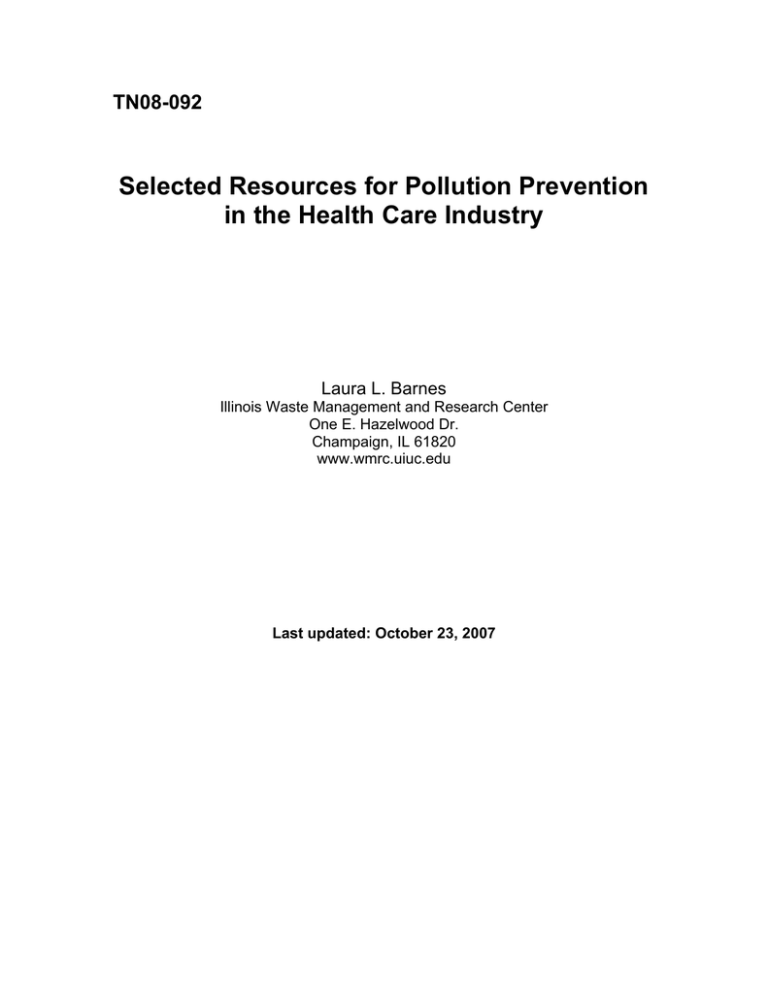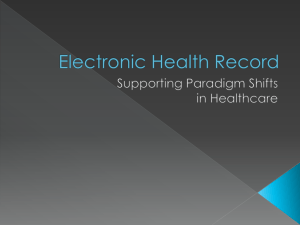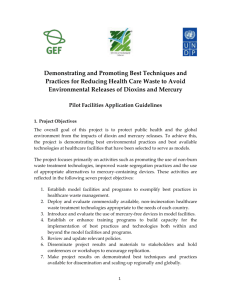Selected Resources for Pollution Prevention in the Health Care Industry TN08-092
advertisement

TN08-092 Selected Resources for Pollution Prevention in the Health Care Industry Laura L. Barnes Illinois Waste Management and Research Center One E. Hazelwood Dr. Champaign, IL 61820 www.wmrc.uiuc.edu Last updated: October 23, 2007 Table of Contents Introduction......................................................................................................................... 3 Background and Overview ................................................................................................. 3 Organizations/Initiatives ..................................................................................................... 6 Facilities Management ........................................................................................................ 7 Green Building.................................................................................................................... 9 Green Pharmacy................................................................................................................ 10 Green Purchasing .............................................................................................................. 12 Hazardous Materials & Regulated Medical Waste Management ..................................... 13 Recycling & Waste Disposal ............................................................................................ 15 Case Studies ...................................................................................................................... 17 Introduction This bibliography supplements a poster session presented at the 2007 Health Science Librarians of Illinois Annual Meeting in Urbana, IL. The poster session is available for viewing as a slide show at http://www.wmrc.uiuc.edu/main_sections/info_services/library_docs/TN/healthcarep2sli des.pdf. Background and Overview Books & Articles American Hospital Association and the U.S. Environmental Protection Agency. Memorandum of Understanding between the American Hospital Association & the U.S. Environmental Protection Agency. Washington, DC : Health Care Without Harm, 2001? American Nurses Association. Pollution Prevention Kit for Nurses. Washington, D.C.: American Nurses Association, 1999. American Society for Healthcare Engineering, and American Hospital Association. Hospitals and the Environment. Chicago, Ill: American Society for Healthcare Engineering, of the American Hospital Association, 1998. Bisson, Connie Leach, McRae, Glenn, Shaner, Hollie Gusky. An Ounce of Prevention: Waste Reduction Strategies for Health Care Facilities. Chicago, IL: American Hospital Association, 1993. Briston, N. (2007). “US Health-care Providers Go ‘Green’.” Lancet 369(9560):453-454. Burnham, M. (2006). “Operation Organic: Anatomy of a Healthy Hospital Movement.” Sustainable Industries Journal April 2006, 11-14. (Online at http://www.sustainableindustries.com/sijnews/2539266.html) Camacho, Charlemagne S. The Development of a Pollution Prevention Assessment Model for Healthcare Facilities. Thesis (M.S.)--Baylor University, 2003. Ceppetelli, Ellen B., and Jeff Farber. The Healthcare Industry's Impact on the Environment Strategies for Global Change [videorecording]. Colchester, Vt: Division of Continuing Education, the University of Vermont, 1998. Ceppetelli, Ellen, Jeff Farber, Jessica Simmon, and Peter Wilder. Managing Healthcare's Waste [videorecording]. [Burlington, Vt.]: University of Vermont, 2000. Ceppetelli, Ellen B. Our Waste, Our Responsibility Moving Toward a Pollution Prevention Approach [videorecording]. [Burlington, Vt.]: University of Vermont, 2000. Dunlop, Shannon-Melissa. Our Environment: A Healthcare Commitment. Peekskill, N.Y.: Doucet & Mainka, P.C., 2002. Frumkin, Howard, and Christine Coussens. Green Healthcare Institutions: Health, Environment, and Economics: Workshop Summary. Washington, D.C.: National Academies Press, 2007. (Online at http://books.nap.edu/openbook.php?isbn=0309105927) Gaudry, J. and K. Skiehar (2007). “Promoting Environmentally Responsible Health Care.” The Canadian Nurse 103(1), 22-26. Heilig S. (2002). “Healthcare Without Harm”. Cambridge Quarterly of Healthcare Ethics 11(2), 203207. Melamed, A. (2003). “Environmental Accountability in Perioperative Settings.” AORN Journal 77(6), 1157-1168. Quinn, M.M.; Fuller, T.P.; Bello, A.; Galligan, C.J. (2006). “Pollution Prevention-Occupational Safety and Health in Hospitals: Alternatives and Interventions.” Journal of Occupational and Environmental Hygiene 3(4), 182-193, quiz D45. A New Prescription: Pollution Prevention Strategies for the Health Care Industry : Proceedings. Tyngsborough, Mass: Boston University Corporate Education Center, 1998. (Online at http://www.p2pays.org/ref/16/15196.pdf) Pierce, Jessica and Andrew Jameton. The Ethics of Environmentally Responsible Health Care. Oxford: Oxford University Press, 2004. Profile of the Healthcare Industry. Washington, D.C.: U.S. Environmental Protection Agency, 2005. (Online at http://www.epa.gov/compliance/resources/publications/assistance/sectors/notebooks/ healthsn2.pdf) Robinson, Lindsay. Managing Healthcare's Waste Developing a Pollution Prevention Model [videorecording]. [Burlington? Vt.]: University of Vermont, 2002. Sattler, B. (2002). “Environmental Health in the Health Care Setting.” American Nurse 34(2), 25-38; quiz 39-40. Shaner, H. and M.L. Botter (2003). “Pollution: Health Care's Unintended Legacy.” American Journal of Nursing 103(3), 79, 81, 83-4. Zimmer, C. (2001). “Time To Go Green! H2E Program Can Provide Environmental and Financial Benefits.” Health Facilities Management 14(4), 33-6. Web Sites Basic Information about Pollution Prevention (P2) http://www.epa.gov/p2/pubs/basic.htm Excellent general discussion of pollution prevention principles. Best References: Hospital and Medical http://wrrc.p2pays.org/indsectinfo.asp?INDSECT=15 GLRPPR Sector Resources > Hospitals and Health Services http://www.glrppr.org/contacts/gltopichub.cfm?sectorid=29 Health Care EnviroNet http://www.c2p2online.com/main.php3?section=83&doc_id=169 Canadian effort to promote pollution prevention and sustainability in the health care sector. Healthcare: Pollution Prevention & Best Management Practices http://www.epa.gov/ne/healthcare/bmp.html Excellent portal to environmental best management practices for all aspects of pollution prevention in the health care industry. Hospital Pollution Prevention http://www.epa.gov/region09/waste/p2/projects/hospart.html Resources from U.S. EPA Region 9. Hospitals for a Healthy Environment Online Library http://www.h2e-online.org/search.cfm P2Rx Topic Hubs and Sector Resources > Medical Care http://www.p2rx.org/P2InfoNexpert/sectorInfo.cfm?SectorID=5 Partnership for Sustainable Healthcare http://www.epa.gov/p2/pubs/psh.htm History of EPA’s involvement with pollution prevention in health care and the establishment of Hospitals for a Healthy Environment. Pollution Prevention Topic Hub http://www.glrppr.org/hubs/toc.cfm?hub=26&subsec=7&nav=7&CFID=323722&CFTO KEN=24771982 U.S. EPA Persistent Bioaccumulative and Toxic (PBT) Chemical Program > Hospital Resources http://www.epa.gov/pbt/pubs/hospitals.htm Organizations/Initiatives American Nurses Association Environmental Health/RnnoHarm http://nursingworld.org/MainMenuCategories/OccupationalandEnvironmental/environme ntalhealth.aspx Great Lakes Regional Pollution Prevention Roundtable (GLRPPR) http://www.glrppr.org Professional organization dedicated to promoting information exchange and networking to P2 professionals in the Great Lakes regions of the United States and Canada. Health Care Without Harm http://www.noharm.org/us Global organization that advocates for more environmentally friendly health care solutions. Healthcare Environmental Resource Center http://www.hercenter.org/index.cfm Hospitals for a Healthy Environment http://www.h2e-online.org Evolved from U.S. EPA’s pollution prevention in health care initiative into its own nonprofit organization that partners with hospitals and healthcare organizations. Nightingale Institute for Health & the Environment http://www.nihe.org/ Although the organization ceased operations in 2006, its web site still has some good resources. Focuses on nurses and the environment. Physicians for Social Responsibility http://www.psr.org/ One of their primary focuses is the environment and health. Women's Health & Environmental Network (WHEN) http://www.when.org/ Mission is to champion the health of women and their families by reducing environmental exposures through education, research and direct action. Their web site includes a section on healthy hospitals. Facilities Management Books & Articles Dunlop, Shannon-Melissa, Tim Piero, and Marcie Wingfield. Healthcare Guide to Pollution Prevention Implementation Through Environmental Management Systems. [Louisville, Ky.]: Kentucky Pollution Prevention Center, 2002. (Online at http://www.kppc.org/Publications/Print Materials/healthcare Guide/hospital manual disclaimer.doc) Eagle, A. (2004). “Clean + Green: Instituting a ‘Green’ Floor Care Program.” Health Facilities Management 17(8), 25-7. Gautam, A.K.; Kumar, S.; Sabumon, P.C. (2007). “Preliminary Study of Physicochemical Treatment Options for Hospital Wastewater.” Journal of Environmental Management 83(3), 298-306. Griffin, W.R. (2001). “Be Chemically Correct! Advice on Managing Your Facility's Cleaning Chemicals.” Health Facilities Management 14(3), 41-44. Hansen, Wayne. A Guide to Managing Indoor Air Quality in Health Care Organizations. An Environment of Care Book. Oakbrook Terrace, Ill: Joint Commission on Accreditation of Healthcare Organizations, 1997. Hodgson, Mark, and Carol L. Shenold. Healthcare Mold Management A Prevention, Assessment, and Remediation Training Guide. Marblehead, MA: HCPro, Inc, 2004. Lehman, D. (2003). “Clean and Green: Implementing Environmentally Friendly Cleaning Practices.” Health Facilities Management 16(3), 48-51. Leung, M. and A.H. Chan (2006). “Control and Management of Hospital Indoor Air Quality.” Medical Science Monitor 12(3), SR17-23. Macdonald, M. (2007). “Processes for Reducing NHS Carbon Footprint.” Health Estate 61(7), 59-61. Mardock, J.E. (2003). “Cleaning Up Our Environmental Footprints.” Health Progress 84(6), 18-21. McKinley, D. and C. Zimmer (2004). “Clean care. Improving the Environment of Care with ‘Green’ Initiatives.” Health Facilities Management 17(3), 40-44. Saving Energy with Energy Efficiency in Hospitals. Sittard, Netherlands: CADDET, 1999. (Online at http://www.caddet.org/public/uploads/pdfs/Brochure/mb_05.pdf) Townend, W.K.; Cheeseman, C.R. (2005). “Guidelines for the Evaluation and Assessment of the Sustainable Use of Resources and of Wastes Management at Healthcare Facilities.” Waste Management & Research 23(5), 398-408. Wagner, Kathryn D., Rounds, Claude D., and Spurgin, Robert A. Environmental Management in Healthcare Facilities. Philadelphia, PA, W.B. Saunders Co, 1998. Web Sites Centre for Analysis and Dissemination of Demonstrated Energy Technologies (CADDET) http://www.caddet.org/index.php CADDET’s objective was to enhance the exchange of information on new, cost-effective renewable energy and energy efficiency technologies. CADDET ceased collecting new information at the end of March 2005. Search using “Hospitals” to locate relevant case studies. ENERGY STAR for Healthcare http://www.energystar.gov/index.cfm?c=healthcare.bus_healthcare Energy efficiency resources targeted at healthcare facilities. Energy Solutions for Your Building: Health Care Buildings http://www.eere.energy.gov/buildings/info/health/index.html Resources from DOE’s Building Technologies Program. Hospitals for a Healthy Environment > Facilities Management http://cms.h2e-online.org/ee/facilities/ P2 for Hospital Sterilizers Topic Hub http://www.glrppr.org/hubs/toc.cfm?hub=1008&subsec=7 Green Building Books & Articles Designing the 21st Century Hospital: Environmental Leadership for Healthier Patients and Facilities. [Concord, CA]: Center for Health Design, 2006. (Online at http://www.rwjf.org/files/publications/other/Report Designingthe21stCenturyHospital-September2006.pdf) Mages, Marilyn E. (2006). “Creating a Green Healing Environment.” Healthcare Executive 21(2), 72-74. Palmateer, Paige (2007). “Survey: Green-building Methods Working for Health-care Facilities.” CNY Business Journal June 15, 2007, no pagination. (Online at http://findarticles.com/p/articles/mi_qa3718/is_20070615/ai_n19430148) Sandrick, K. (2003). “Building a Green Future with Environmentally Friendly Construction Materials.” Health Facilities Management 16(2), 14-18. Shinn, Kim (2006). “LEED in Healthcare.” Plumbing & Mechanical 24(8), 92-95. Shinn, Kim E., and Tilden Lobnitz. The Growth of the ‘Green Building’ Initiative. Chicago, Ill: ASHE, 2002. Weller, K. (2006). “The Top 10 Green Hospitals in the U.S.: 2006.” The Green Guide #113, no pagination. (Online at http://www.thegreenguide.com/doc/113/top10hospitals) Web Sites American Society for Healthcare Engineering http://www.ashe.org/ Hospitals for a Healthy Environment > Green Building http://cms.h2e-online.org/ee/facilities/greenbuilding/ U.S. Green Building Council http://www.usgbc.org/ Green Pharmacy Articles -- (2007). “Facts on Pharmaceuticals and the Environment.” Symbiosis 4(2), 30. (Online at http://www.teleosis.org/pdf/symbiosis/Facts4.2.pdf) Daughton, C.G. (2003). “Cradle-to-cradle Stewardship of Drugs for Minimizing Their Environmental Disposition While Promoting Human Health. I. Rationale for and Avenues toward a Green Pharmacy.” Environmental Health Perspectives 111(5), 757-774. (Online at http://www.ehponline.org/members/2003/5947/5947.pdf) Daughton, C.G. (2003). “Cradle-to-cradle Stewardship of Drugs for Minimizing Their Environmental Disposition while Promoting Human Health. II. Drug Disposal, Waste Reduction, and Future Directions. Environmental Health Perspectives 111(5), 775-785. (Online at http://www.ehponline.org/members/2003/5948/5948.pdf) Daughton, C.G. (2003). “Environmental Stewardship of Pharmaceuticals: The Green Pharmacy.” in Proceedings of the 3rd International Conference on Pharmaceuticals and Endocrine Disrupting Chemicals in Water: National Ground Water Association, 19-21 March 2003, Minneapolis, MN, 11 p. (Online at http://www.bioud.com/Documents/ngwa2003.pdf) Desai, N. (2007). “Ecological Economics and the Drug Life Cycle: The True Cost of Drugs.” Symbiosis 4(2), 31-38 (2007). (Online at http://www.teleosis.org/pdf/symbiosis/EcoEconomics4.2.pdf) Kriesberg, J. (2007). “The 4 T’s: Assessing Exposure to Multiple Chemicals.” Symbiosis 4(2), 22-24. (Online at http://www.teleosis.org/pdf/symbiosis/4Ts_4.2.pdf) Kriesberg, J. (2007). “Christian Daughton and the Ecology of PPCPs: An Integral Vision.” Symbiosis 4(2), 14-16. (Online at http://www.teleosis.org/pdf/symbiosis/Daughton_Integral4.2.pdf) Kriesberg, J. (2007). “Green Pharmacy: Preventing Pollution.” Symbiosis, 4(2), 25-29. (Online at http://www.teleosis.org/pdf/symbiosis/GreenPharmacy4.2.pdf) Kriesberg, J. (2007). “Pharmaceutical Pollution: Ecology and Toxicology Considerations.” Symbiosis 4(2), 4-13. (Online at http://www.teleosis.org/pdf/symbiosis/Intro_EcoTox4.2.pdf) Mireles, M. (2007). “Unused and Expired Medicines: A National Pandemic.” Symbiosis 4(2), 40-42. (Online at http://www.teleosis.org/pdf/symbiosis/UEM4.2.pdf) Web Sites GLRPPR Sector Resources > Pharmaceuticals & Personal Care Product (PPCP) Wastes & Impacts http://www.glrppr.org/contacts/gltopichub.cfm?sectorid=142 Managing Pharmaceutical Waste: A 10-Step Blueprint for Health Care Facilities In the United States (Draft) http://www.hercenter.org/hazmat/pharmblueprint.cfm Pharmaceutical Waste in Health Care Facilities http://www.hercenter.org/hazmat/pharma.cfm Teleosis Institute http://www.teleosis.org Devoted to developing effective, sustainable health care provided by professionals who serve as environmental stewards. Focus on green pharmacy. Green Purchasing Articles ---. (2003). “Green Purchasing: Substituting Environmentally Preferred Alternatives.” Healthcare Hazard Management Monitor 17(1), 1-10. Eagan, Patrick D. and Barb Kaiser. (2002) “Can Environmental Purchasing Reduce Mercury in U.S. Health Care?” Environmental Health Perspectives 110(9), 847-851. (Online at http://www.ehponline.org/members/2002/110p847851eagan/EHP110p847PDF.PDF). Greene, J. (2002). “Heavy Metal: Weighing the Mercury-free Options.” Materials Management in Health Care 11(12),14-18. Kaiser, Barb; Patrick D. Eagan; H. Shaner (2001). “Solutions to Health Care Waste: Lifecycle Thinking and “Green” Purchasing.” Environmental Health Perspectives 109(3), 205-207. (Online at http://www.ehponline.org/members/2001/109p205207kaiser/kaiser.pdf) Kaiser, Barbara A. The Health Care Environmental Purchasing Tool Development and Pilot Testing of a New Pollution Prevention Method. Thesis (M.S.)--University of Wisconsin--Madison, 2001. Livingston, J. (2003). “Being Environmentally Responsible: Group Purchasing Practices Can Help Hospitals Protect the Environment.” Health Progress 84(1), 46-49. Sutherland, L. (2000). “Purchasing for a Healthy Environment.” Materials Management in Health Care 9(9), 30-33. Web Sites Health Care Environmental Purchasing Tool (HCEPT) http://www.ahrmm.org/ahrmm/resources_and_tools/purchasing_tool/index.html Hospitals for a Healthy Environment > Green Purchasing (EPP) http://cms.h2e-online.org/ee/waste-reduction/epp/ Sustainable Hospitals Project http://www.sustainablehospitals.org Excellent resource for environmentally friendly alternatives to common health care products. Hazardous Materials & Regulated Medical Waste Management Books & Articles Eliminating Mercury in Hospitals: Environmental Best Practices for Health Care Facilities. [Washington, DC?]: U.S. Environmental Protection Agency, 2002. (Online at http://www.ciwmb.ca.gov/WPIE/HealthCare/EPAHgInHosp.pdf). Hylander, L.D. and M.E. Goodsite (2006). “Environmental Costs of Mercury Pollution.” Science of the Total Environment 368(1), 352-370. Lead, Cadmium and Mercury in Hospital Solid Waste: A Scoping Study. Boston, MA : Northeast Waste Management Officials' Association, 1992. (Online at http://www.p2pays.org/ref/19/18533.pdf) Reducing Mercury Use in Health Care Promoting a Healthier Environment : a How-to Manual. [Washington, D.C.]: United States Environmental Protection Agency, 2000. (Online at http://www.epa.gov/glnpo/bnsdocs/merchealth/) Weber, L.J. (2000). “Medical Waste and Healthcare Ethics.” Health Progress 81(1), 268, 32. Williams, Guy O. Mercury Pollution Prevention in Healthcare: A Prescription for Success. Ann Arbor, Mich: National Wildlife Federation, Great Lakes Natural Resource Center, 1997. (Online at http://www.newmoa.org/prevention/topichub/22/Mercury_Pollution_Prevention_in_ Healthcare_NWF.htm) Zanoni, Pier-George. Mercury Elimination/Pollution Prevention Strategies. Healthcare facilities management series, no. 043133. Chicago, Ill: American Society for Healthcare Engineering of the American Hospital Association, 2000. Web Sites EPA New England Hospital Environmental Assessment Template http://www.epa.gov/region1/healthcare/pdfs/EPAHospitalTool.pdf GLRPPR Sector Resources > Hospitals & Health Services > Mercury http://www.glrppr.org/contacts/gltopichub.cfm?sectorid=29#130 Healthcare Environmental Resource Center > Hazardous Materials http://www.hercenter.org/hazmat/hazoverview.cfm Healthcare Environmental Resource Center > Regulated Medical Waste http://www.hercenter.org/rmw/rmwoverview.cfm Hospitals for a Healthy Environment > Hazardous Materials http://cms.h2e-online.org/ee/hazmat/ Hospitals for a Healthy Environment > Regulated Medical Waste http://cms.h2e-online.org/ee/rmw/ Medical Waste http://www.epa.gov/epaoswer/other/medical/ U.S. EPA portal to resources about regulated medical waste, including sharps disposal. Mercury – Health Care Topic Hub http://www.glrppr.org/hubs/toc.cfm?hub=502&subsec=7 Mercury – Thermometers Topic Hub http://www.glrppr.org/hubs/toc.cfm?hub=101&subsec=7 Mercury: Information for Health Care Providers http://www.epa.gov/hg/healthcare.htm Mercury Elimination and Reduction Challenge http://www.pollutionprobe.org/merc/merc.htm Canadian mercury elimination effort. Recycling & Waste Disposal Books & Articles Cutting into Karapitiya Hospital’s Solid Waste Problem. Washington, DC : U.S. Agency for International Development, 200?. (Online at http://www.usaid.gov/lk/documents/tos/USAEP_karapitiyahospital_solidwaste.pdf) Dilly, G.A. and C.W. Shanklin (2000). “Solid Waste Management Practices in U.S. Army Medical Treatment Facilities.” Military Medicine 165(4), 302-304. Donston, Debra (2007). “Hospital Finds Recycling Cure.” EWeek.com October 13, 2007, no pagination. (Online at http://www.eweek.com/article2/0,1895,2195693,00.asp) Ferreira, A.P. and M.M. Veiga (2003). “Hospital Waste Operational Procedures: A Case Study in Brazil.” Waste Management Research 21(4), 377-382. Hospital Waste Management 101. Lyme, NH: Hospitals for a Healthy Environment, 2007. (Online at http://www.h2e-online.org/docs/summit2007datacollection.pdf) Hildebrandt, C.C. and T.K. Boguksi (1993). “Life Cycle Analysis of Health-care Packaging and Materials.” Medical Waste Analysis 2(2), 7-9. Karamouz, M.; Zahraie, B.; Kerachian, R.; Jaafarzadeh, N.; Mahjouri, N. (2007) “Developing a Master Plan for Hospital Solid Waste Management: A Case Study.” Waste Management 27(5), 626-638. Laustsen, G. (2007). “Reduce -- Recycle -- Reuse: Guidelines for Promoting Perioperative Waste Management.” AORN Journal 85(4), 717-722. Lee, B.K.; Ellenbecker, M.J.; Moure-Eraso, R. (2002). “Analyses of the Recycling Potential of Medical Plastic Wastes.” Waste Management 22(5), 461-70. Rainbird, James (2003). “Waste Not, Want Not.” HD 34(2), 37+. Robichaud, R.; Cormier, A.; Gaudet-Leblanc, C. (1995). “Survey of Food-related Waste Management Practises in New Brunswick Health Establishments.” Journal of the Canadian Dietetic Association 56(1), 35-9. Wahel, R.N. (2006). “Health Care Waste Management.” Paper presented at the All India Seminar on Solid Waste Management in Urban Areas 10-11 February 2006, Mumbai. p. 18-19. (Online at http://www.karmayog.com/images/swmuarea18.pdf) Waste Management 101 – A “Brown” and “Green” Hospital Comparison. Lyme, NH: Hospitals for a Healthy Environment, 200?. (Online at http://www.h2eonline.org/docs/h2ewastemanagement101.pdf) U.S. Environmental Protection Agency. Fletcher Allen Health Care: Burlington, VT: 90% Recovery of Preconsumer Food Discards. Washington, DC : U.S. Environmental Protection Agency Office of Solid Waste and Emergency Response, 1998. (Online at http://www.epa.gov/epaoswer/non-hw/reduce/food/food2.pdf) Zanoni, P.G. (2003). “E-waste Elimination: Electronic Recycling Tips for the Health Care Industry.” Health Facilities Management 16(8), 39-41. Web Sites Healthcare Environmental Resource Center > Waste Reduction – Landscaping and Food Waste http://www.hercenter.org/wastereduction/yardandfood.cfm Hospital Recycling Program (Michigan DEQ) http://www.deq.state.ms.us/MDEQ.nsf/page/Recycling_HospitalRecyclingProgram?Ope nDocument Hospitals for a Healthy Environment > Recycling http://cms.h2e-online.org/ee/waste-reduction/recycling/ Hospitals for a Healthy Environment > Solid Waste Disposal http://cms.h2e-online.org/ee/waste-reduction/solid-waste-disposal/ Waste Reduction Activities for Hospitals http://www.ciwmb.ca.gov/BIZWASTE/factsheets/hospital.htm Case Studies Best References: Hospital and Medical > Case Studies http://wrrc.p2pays.org/indsectinfo.asp?INDSECT=15#Case%20Studies Boulder Community Foothills Hospital http://www.cement.org/buildings/buildings_green_boulder.asp Dedicated in September 2003, the $53M Boulder Community Foothills Hospital became the first hospital in the nation to receive LEED certification from the U.S. Green Building Council. Centre for Analysis and Dissemination of Demonstrated Energy Technologies (CADDET) http://www.caddet.org/index.php CADDET’s objective was to enhance the exchange of information on new, cost-effective renewable energy and energy efficiency technologies. CADDET ceased collecting new information at the end of March 2005. Search using Hospitals to locate relevant case studies. Cutting into Karapitiya Hospital’s Solid Waste Problem. Washington, DC : U.S. Agency for International Development, 200?. (Online at http://www.usaid.gov/lk/documents/tos/USAEP_karapitiyahospital_solidwaste.pdf) U.S. Environmental Protection Agency. Fletcher Allen Health Care: Burlington, VT: 90% Recovery of Preconsumer Food Discards. Washington, DC : U.S. Environmental Protection Agency Office of Solid Waste and Emergency Response, 1998. (Online at http://www.epa.gov/epaoswer/non-hw/reduce/food/food2.pdf) Gowande, S. (2006). “Hospital Solid Waste and its Management Approach- A Case Study of a Hospital in Akola District of Maharashtra.” Paper presented at the All India Seminar on Solid Waste Management in Urban Areas 10-11 February 2006, Mumbai. p. 76-77. (Online at http://www.karmayog.com/images/swmuarea76.pdf) Healthcare EnviroNet Case Studies http://www.c2p2online.com/main.php3?session=&section=88&doc_id=174 Case studies that show what Canadian hospitals are doing to promote pollution prevention and sustainability. Hettenbach, Todd. Greening Hospitals: An Analysis of Pollution Prevention in America's Top Hospitals. Washington, DC: Health Care Without Harm, 1998. North Country Hospital Biomass Conversion And Cogeneration Project. Golden, CO: U.S. Department of Energy, Energy Efficiency and Renewable Energy, 2006. (Online at http://www1.eere.energy.gov/biomass/pdfs/north_country.pdf) Pollution Prevention Works for Iowa: Health Care Case Summaries. Des Moines, IA: Iowa Dept. of Natural Resources, 1996. (Online at http://www.p2pays.org/ref%5C06/05843.pdf) The Nation’s Greenest Hospital (Providence Health System, Newberg OR) http://www.providence.org/yamhill/new_medical_center/green.htm





